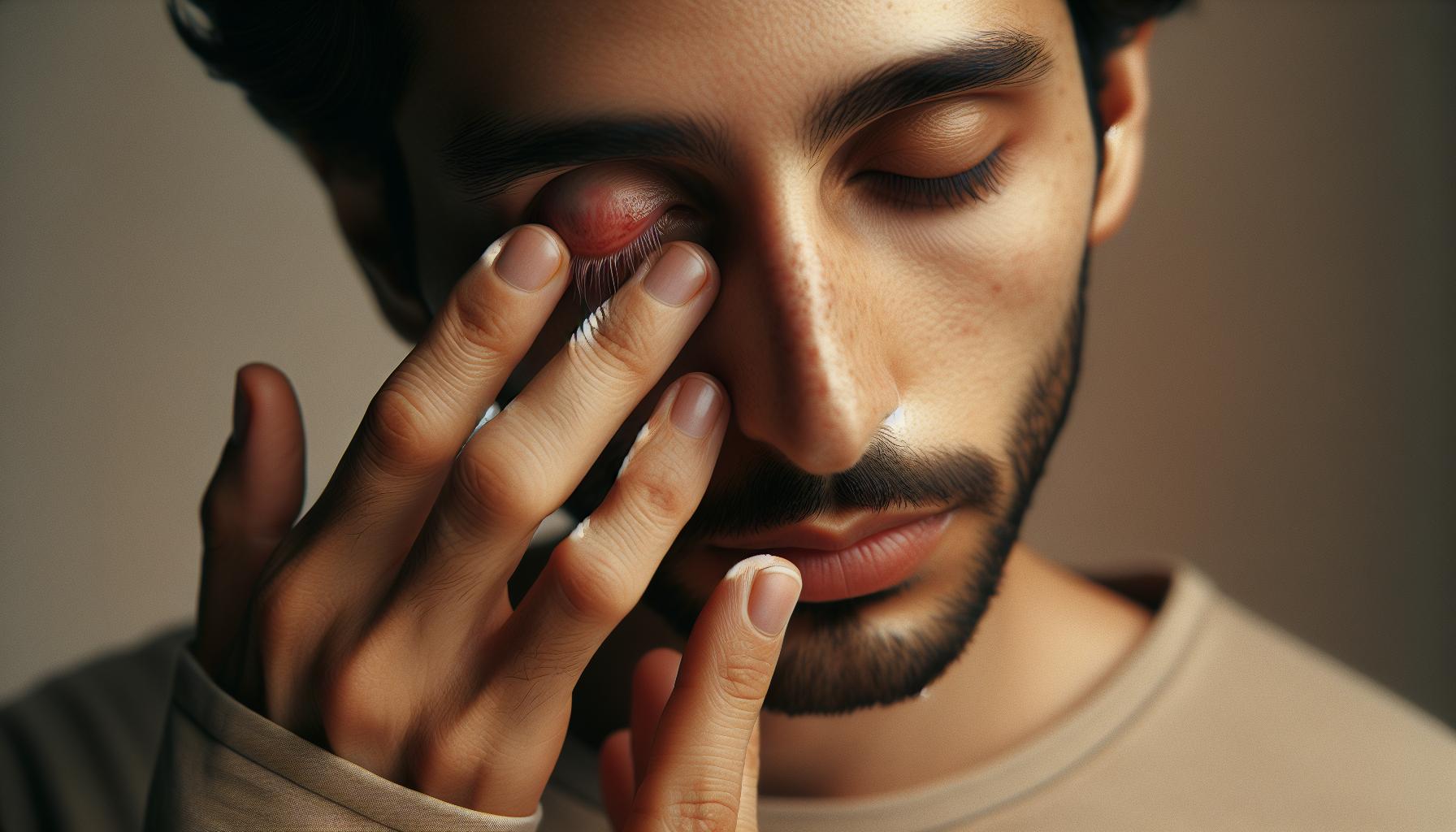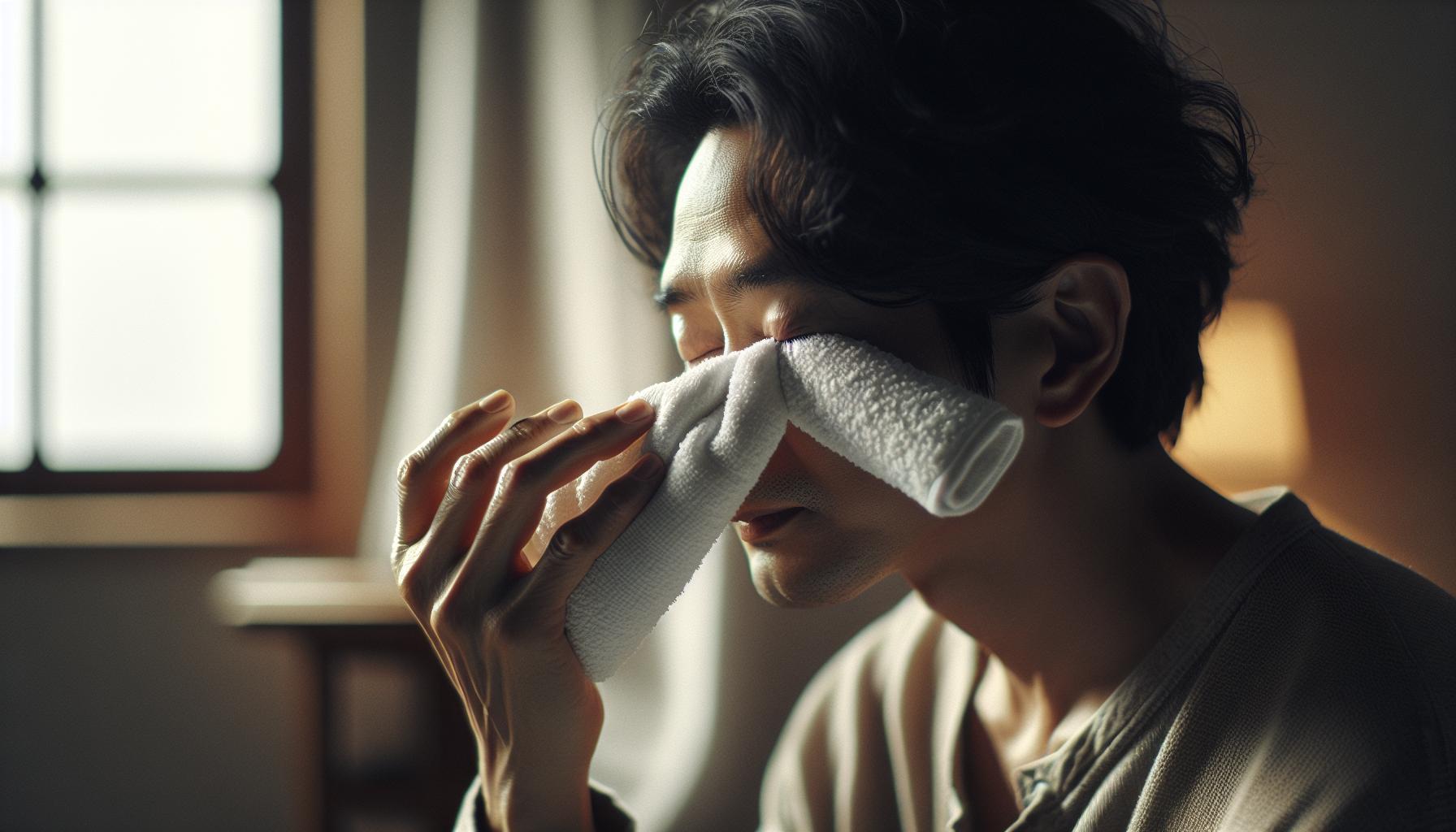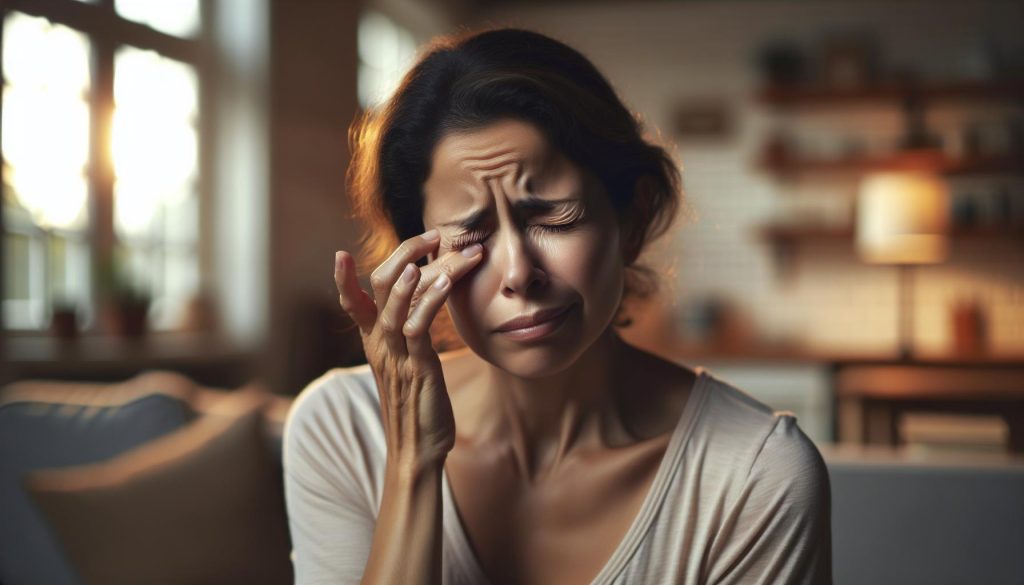Styes can be more than just a mere nuisance; they can lead to discomfort and watery eyes, leaving you frustrated and self-conscious. Understanding the connection between styes and excessive tearing is essential for effective treatment and relief. When a stye forms due to bacterial infection in the oil glands of your eyelid, it can cause inflammation that triggers your tear glands, leading to that all-too-familiar watery feeling.
If you’ve ever found yourself wondering why your eyes seem to be constantly watering, this article will provide clarity on the relationship between styes and eye tears, as well as actionable insights to help you manage symptoms and regain comfort. Join us in exploring the causes of styes, how they affect your eyes, and practical steps you can take to put an end to the tears, empowering you to feel your best every day.
Understanding Styes: What Are They and Why They Occur
Understanding the formation of styes is essential for addressing the uncomfortable symptoms they bring. A stye, or hordeolum, is typically caused by a bacterial infection in the oil glands at the edge of your eyelid, leading to painful, swollen bumps. They are characterized by tender, red lumps that develop near the eyelashes, often accompanied by irritation and a feeling of grit in the eye. While anyone can be affected, those with oily skin, blepharitis (eyelid inflammation), or who frequently wear eye makeup may be more prone to developing styes.
The bacteria responsible, usually Staphylococcus aureus, can thrive in clogged glands, resulting in inflammation and blockage. Stress, hormonal changes, and lack of sleep can also weaken the immune system, making it easier for these infections to occur. Though initially minor, styes can escalate into more significant problems if the bacteria spread or if the bump becomes persistent, necessitating clinical intervention. Understanding these causes not only helps demystify the discomfort you may feel but also empowers you to take proactive steps in managing your eye health.
Once you are aware of the main triggers, you can easily adjust your habits. Regularly cleaning your eyelids can prevent buildup, and incorporating warm compresses may ease discomfort and encourage drainage. Ultimately, knowing what a stye is and what leads to its formation allows you to feel more in control of your eye health and take action to mitigate discomfort.
Do Styes Really Cause Excessive Tear Production?
Experiencing watery eyes can be a frustrating symptom, but it’s important to understand how styes might relate to excessive tear production. While styes themselves primarily arise due to a bacterial infection in the oil glands of the eyelid, their presence can trigger an unintentional response from your body, leading to watery eyes. The irritation and inflammation caused by the stye can stimulate your tear glands, which may result in increased tear production as your eyes attempt to flush out the irritants and soothe the affected area.
When a stye forms, it often brings along symptoms like redness, swelling, and tenderness. This inflammation can irritate the eye, prompting it to produce more tears. Interestingly, this excessive tearing can sometimes make the situation seem worse, as the constant flow of tears might not only fail to alleviate discomfort but can also blur vision temporarily, creating a cycle of irritation. If the tear ducts become overwhelmed by the excess tears, it may even lead to watering that seems disproportionate to the initial stye.
To manage this excessive tearing, maintaining good eyelid hygiene is crucial. Regularly cleaning the eyelids with warm compresses can help reduce irritation, prevent further inflammation, and promote drainage of the stye. If your eyes continue to water excessively despite these measures, consider discussing your symptoms with a healthcare professional who can offer tailored advice or treatment options. It’s vital to recognize that while styes can lead to watering eyes, understanding the underlying causes equips you to take control of your eye health effectively.
How to Identify Symptoms of a Stye
A stye is not just an annoying eyelid bump; it’s a sign that your body is responding to an infection. To identify a stye, look for specific symptoms that can help you differentiate it from other eyelid issues. Common signs include a red, swollen bump near the base of your eyelashes that may feel painful or tender to the touch. Often these bumps can progress to a pus-filled formation, resembling a small pimple.
The discomfort often escalates as the stye develops. You might notice an increased sensitivity to light, a feeling of grittiness in your eye, or even swelling of the entire eyelid. As the inflammation intensifies, some individuals report experiencing excessive tearing due to irritation; this occurs when the body tries to flush out the irritant. To be attentive to these changes, consider monitoring your eyelid hygiene and how your eyes feel overall. If you detect any combination of these symptoms, it’s wise to take action to soothe your discomfort and prevent further irritation.
To help pinpoint a stye more effectively, consider keeping track of your symptoms. You might want to observe the size of the bump, any accompanying redness, swelling levels, and whether you’re experiencing additional symptoms such as changes in your vision or secretions from your eyes. Regularly performing gentle eyelid cleaning with warm compresses can not only provide immediate relief but also assist in managing and identifying the problem early on.
If you suspect that you have a stye, remember to take note of your symptoms and their progression. Should the stye persist for more than a few days, bleed, or if vision becomes blurred, it’s important to consult with a healthcare professional. This approach empowers you to take charge of your eye health without unnecessary distress, ensuring you can enjoy life without the nagging discomfort of a stye.
Effective Home Remedies for Stye Relief
One of the most comforting remedies for styes is the simple and effective warm compress. This easy method not only provides immediate relief from discomfort but also promotes drainage and healing of the stye. To prepare a warm compress, soak a clean cloth in warm water, wring it out, and gently place it over the affected area for about 10-15 minutes. Repeat this process several times a day to help reduce swelling and irritation. Additionally, you can enhance the effects by incorporating a few drops of tea tree oil, known for its antibacterial properties, mixed with a carrier oil, but be sure to perform a patch test first to avoid any adverse reactions.
Another home remedy to consider is eyelid hygiene, which plays a crucial role in preventing future occurrences of styes. Regularly cleaning your eyelids with a gentle eyelid scrub or diluted baby shampoo can help eliminate impurities that may contribute to clogged glands. Make it a routine, especially if you wear makeup or have oily skin, to ensure your eyelids are kept clean and free from irritants.
Gentle massage techniques can also aid in alleviating discomfort. Once you have applied a warm compress, gently massaging the area can help encourage the drainage of the stye. Use clean fingertips to softly move along the edges of the bump, which could reduce the feeling of grittiness in your eye and promote comfort.
Incorporating foods rich in antioxidants, such as berries, spinach, and sweet potatoes, into your diet can support overall eye health. Staying hydrated is equally important, as it boosts your immune system and may reduce the likelihood of inflammatory responses, including those that lead to styes. Remember, while these remedies can provide relief and aid in healing, it’s crucial to consult with a healthcare provider if the stye persists or worsens, ensuring ongoing care aligns with your overall eye health needs.
Professional Treatments for Persistent Styes
Persistent styes can be frustrating, often leading to discomfort and affecting daily activities. When home remedies such as warm compresses and eyelid hygiene don’t yield the desired results, there are professional treatments available to alleviate the symptoms and address the underlying causes effectively.
For styes that are particularly stubborn or have become larger, medical intervention may be necessary. An eye care professional may prescribe antibiotic ointments or eyedrops to combat any potential infection, especially if the stye shows signs of spreading or worsening. In cases where the stye does not respond to topical treatments, oral antibiotics may be prescribed to tackle the infection more aggressively.
If a stye continues to persist, doctors can perform a simple in-office procedure known as lancing. This involves making a small incision to allow the stye to drain, significantly reducing swelling and promoting healing. The procedure is typically quick, and local anesthesia is used to minimize discomfort during the process. The eye care professional will provide thorough aftercare instructions to ensure optimal recovery.
In addition to medications and procedures, addressing lifestyle factors can play a crucial role in managing styes effectively. Maintaining proper eyelid hygiene, avoiding potential irritants, and managing underlying conditions like blepharitis can go a long way in preventing styes from recurring. Seeking advice from your healthcare provider can empower you with personalized strategies to manage and prevent styes, ensuring that your eyes remain healthy and comfortable.
Preventive Measures: How to Avoid Styes
It’s astonishing how a small bump on your eyelid, known as a stye, can create a cascade of discomfort and irritation, making even simple tasks like applying makeup or using contact lenses a challenge. To prevent styes and maintain eye health, adopting a few straightforward yet effective practices is essential. These measures not only reduce the risk of developing styes but also enhance overall eye comfort and appearance.
One of the primary ways to prevent styes is by ensuring meticulous eyelid hygiene. Gently washing your eyelids with a mild soap or eyelid scrub can help keep oil glands unclogged. Opt for products specifically designed for eye care or make your own saline solution. Frequent cleansing, especially after wearing makeup or engaging in activities that expose your eyes to dust and pollutants, is crucial.
Another preventive strategy involves your makeup and skincare habits. Avoid sharing cosmetics, especially eye makeup, as this can transfer bacteria. Always remove eye makeup before sleeping; consider using a gentle, oil-free remover. If you wear contact lenses, ensure they are cleaned properly and avoid contact lens wear during an active stye outbreak to reduce irritation.
Additionally, consider lifestyle adjustments that benefit your overall eye health. Staying hydrated promotes healthy tear production, while a diet rich in omega-3 fatty acids may help reduce inflammation in the eyelid glands. Incorporating foods such as salmon, flaxseeds, and walnuts could add both health and beauty benefits to your routine.
Lastly, if you’re prone to styes, implementing routine eye care is essential. Regular visits to an eye care professional can provide personalized strategies and early interventions to prevent recurrent issues. By adopting these practices, you can help safeguard your eyes from the discomfort of styes while maintaining a confident and vibrant appearance.
Myths and Facts About Styes and Eye Health
Myths surrounding styes can often contribute to unnecessary worry and misunderstanding about eye health. One common misconception is that styes are contagious. The truth is they are not transmissible; however, bacteria causing styes can spread through direct contact or sharing personal items like towels or makeup, leading to new stye formations rather than spreading an existing one. Understanding this can ease anxiety for those who suffer from recurrent styes.
Another myth suggests that styes occur only due to poor hygiene. While keeping eyelids clean is essential in preventing styes, other factors such as hormonal changes, stress, and certain skin conditions also play a significant role. In reality, anyone can develop a stye, regardless of how meticulously they maintain their eye hygiene.
It’s also worth addressing the belief that styes will always lead to excessive tearing. Although styes can cause discomfort or irritation, they don’t necessarily produce excess tears. Instead, symptoms may include redness, swelling, and a tender bump on the eyelid, which can lead to a slight increase in tear production as the eye works to soothe the irritation. However, any significant increase in wateriness should be evaluated, as it could indicate another underlying issue.
Finally, many people wonder if they should squeeze or pop a stye, similar to a pimple. This notion should be firmly dispelled. Attempting to pop a stye can introduce additional bacteria and may even worsen the condition, leading to further complications. Instead, warm compresses and proper hygiene are recommended for soothing and managing stye symptoms effectively.
In summary, debunking myths about styes helps clarify the significance of proper eye care and the natural course of these benign bumps. By understanding these facts, individuals are better equipped to manage their eye health proactively and feel empowered in their daily routines.
When to Seek Medical Attention for Styes
If you’re dealing with a stye and find that it isn’t responding to at-home treatments or is causing persistent discomfort, it might be time to consider seeking professional medical advice. Recognizing when a stye requires further attention can significantly impact both your eye health and overall comfort. For instance, if the stye is not improving after a few days of home care, such as warm compresses, this could indicate a more complicated issue that necessitates a doctor’s evaluation.
Another critical sign that calls for medical attention is if the stye becomes increasingly painful, swollen, or red. These changes can suggest that the infection is worsening or spreading. Additionally, if you notice changes in your vision or experience excessive tearing, this could signal that the condition is affecting more than just the eyelid and should not be overlooked.
In some cases, styes can develop into chalazia, which are swollen lumps that can last for weeks or even longer if not treated properly. If your stye develops into a chalazion-characterized by prolonged swelling without signs of pus-consider consulting your healthcare provider. They may recommend treatments such as prescription medications, injections, or even a minor procedure to drain the cyst.
Consulting an eye care professional is particularly essential for individuals with conditions such as diabetes or compromised immune systems, as they may be more susceptible to complications from what is typically a mild condition. Overall, keeping a close eye on your symptoms and not hesitating to reach out for professional help can ensure that your eye health stays on track, allowing you to manage discomfort effectively and continue enjoying life without the constant distraction of styes.
The Link Between Styes and Eye Irritation
A stye can unexpectedly disrupt your daily life, leading to discomfort and even a constant flow of tears. This common eye condition arises when an oil gland in your eyelid becomes infected, resulting in a painful lump that can irritate the surrounding areas. The irritation caused by the stye often leads to reflexive tearing, as the body attempts to flush out the perceived threat or discomfort from the eye. This response makes it essential to understand the connection between styes and eye irritation, particularly for individuals seeking relief from excessive watering.
When dealing with a stye, it’s crucial to recognize the symptoms that often accompany it. These include not just the obvious redness and swelling, but also a sensitivity to light and a gritty sensation, like having something stuck in your eye. Such feelings can exacerbate tear production, creating a frustrating cycle whereby tears are triggered in response to irritation, yet the stye continues to irritate the eye due to its position.
Managing irritation is vital to reducing tear production and promoting healing. Gentle practices you can incorporate include applying warm compresses to the affected area for about 10-15 minutes several times a day. This warmth can help soothe irritation, reduce swelling, and promote drainage of the stye. Additionally, consider adopting an eye care routine that prioritizes hygiene-washing your eyelids with mild soap and water may help keep your eyelids free of bacteria, further reducing irritation.
To minimize the emotional toll of a stye, recognizing triggers and taking preventive measures are key. Avoid rubbing your eyes, as this can worsen irritation and increase tear production. Also, refrain from using eye makeup until the stye has healed; this helps prevent further irritation and keeps the area clean. With these strategies, you can alleviate the discomfort associated with styes and work towards a more comfortable, tear-free experience.
Tips for Managing Eye Discomfort from Styes
Applying effective strategies for managing discomfort from styes can significantly improve your quality of life during an episode. The key lies in understanding how to relieve irritation and promote healing while minimizing excessive tearing, which is often a frustrating side effect of having a stye.
First and foremost, utilizing warm compresses can be a game-changer. Take a clean, soft cloth, soak it in warm water (not too hot to avoid burning your sensitive skin), and gently place it over your closed eyelid for about 10-15 minutes. This soothing treatment not only alleviates pain but also encourages drainage, potentially reducing the swelling and irritation caused by the stye. Aim to do this several times a day for the best results.
Maintain Proper Hygiene
It’s crucial to keep your eyelid area clean to prevent further irritation or infection. Use a mild soap or eyelid scrub that’s specific for this purpose-look for ingredients like baby shampoo or other gentle cleansers. When washing your eyelids, do so with your fingertips and ensure you rinse thoroughly. Avoid touching or rubbing your eyes, which can exacerbate the condition.
Hydration and Nutrition
Don’t underestimate the power of hydration and a balanced diet in supporting your body’s healing process. Drinking plenty of water helps maintain optimum moisture levels in your body, which can alleviate some eye irritation. Incorporating foods rich in omega-3 fatty acids, like fish, flaxseeds, and walnuts, can also help reduce inflammation overall, aiding your recovery from styes.
Remember, patience is key when dealing with a stye. While it can be uncomfortable and inconvenient, combining these gentle care tips can usher in relief and help you regain your normal daily routine more swiftly. If discomfort persists, or if you notice changes in vision or increased swelling, it would be wise to seek professional guidance.
How Styes Affect Your Daily Life and Activities
Living with a stye can significantly disrupt your daily life, causing discomfort that ripples into various activities. Many people find that the presence of a stye not only brings physical pain but also emotional distress, as the discomfort is often accompanied by excessive tearing, which further complicates an already challenging situation. Daily tasks, from working at a computer to enjoying simple leisure activities, can become frustrating when your eyes water uncontrollably, hampering your focus and social interactions.
Emotional Impact and Socialization
The visibility of a stye can evoke self-consciousness, affecting how you interact with others. Whether at work, during social outings, or while participating in family events, the worry about appearance might overshadow your enjoyment. Tearing can lead to blurred vision, making it difficult to engage fully in conversations or activities. This emotional toll can result in increased anxiety and avoidance of situations where you would typically feel confident.
Daily Routines and Self-Care
Incorporating self-care routines becomes crucial when battling a stye. Activities like applying makeup may feel daunting or undesirable, as it risks further irritation. Moreover, feeling less than your best can limit social participation. It’s vital to prioritize simple, effective home remedies such as warm compresses and maintaining proper hygiene to manage discomfort. The goal is to promote healing while minimizing eye irritation.
Work and Productivity Challenges
A stye can interfere with your productivity, especially if your work involves screen time. Excessive tearing can lead to difficulty concentrating, resulting in slower work progression and potential frustration. Introducing regular breaks and utilizing the 20-20-20 rule-looking at something 20 feet away for 20 seconds every 20 minutes-can alleviate some discomfort and help to refocus your eyes.
Navigating daily life with a stye doesn’t have to feel overwhelming. Understanding how to manage its symptoms effectively empowers you to maintain your routines and continue to engage fully with those around you. Prioritizing eye care and maintaining a positive outlook can help mitigate some of the challenges associated with this condition.
Q&A
Q: Why do styes cause watery eyes?
A: Styes can lead to watery eyes due to inflammation and irritation of the eyelid. The body’s response includes increased tear production to flush out bacteria and soothe the affected area. Proper care, such as warm compresses, can help alleviate symptoms. For more insights, see our section on how styes can irritate your eyes.
Q: Can styes lead to more serious eye problems?
A: While styes are generally harmless, they can sometimes lead to complications like conjunctivitis or cellulitis if not treated properly. It’s crucial to monitor the stye and consult a healthcare professional if symptoms worsen or persist. Read about when to seek medical attention for styes in our article.
Q: How can I prevent styes from causing tears?
A: Preventing styes involves good hygiene, such as regularly washing your hands and avoiding touching your eyes. Additionally, ensuring proper makeup removal can help maintain eyelid health. For detailed preventive measures, refer to our prevention section.
Q: Are there any home remedies to stop excess tearing from styes?
A: Yes, applying warm compresses for 10-15 minutes can reduce tearing and relieve discomfort caused by styes. This method aids in drainage and promotes healing. Explore more effective home remedies in our relief section.
Q: What should I avoid if I have a stye to reduce tears?
A: To minimize tearing, avoid wearing eye makeup and contact lenses until the stye heals. These can irritate the eye further. For a breakdown of dos and don’ts during a stye, check out our managing tips.
Q: How long do watery eyes from a stye last?
A: Watery eyes from a stye typically resolve as the stye begins to heal, usually within a few days. If tearing persists beyond this time, consider seeking advice from a healthcare provider. Consult our article to know when to seek medical assistance.
Q: Are styes contagious if they cause watery eyes?
A: No, styes are not contagious. They are usually caused by blocked oil glands or bacterial infections on the eyelid, which cannot spread from person to person. For more myths and facts about styes, refer to our myths section.
Q: What are the first signs that my stye is getting worse?
A: If you notice increasing pain, swelling, redness spreading, or persistent watery eyes, these could indicate a worsening stye. Seek medical attention promptly in such cases. For further information on symptoms and when to act, review our symptom identification section.
Insights and Conclusions
Experiencing watery eyes due to styes can be frustrating, but knowing how to address and manage this common issue empowers you to take control of your eye health. Remember, effective treatments include warm compresses, proper hygiene, and sometimes professional care if symptoms persist. Don’t let discomfort hold you back-consider implementing these strategies today for relief and recovery.
For additional insights, check out our articles on How to Care for Your Eyes and Skincare Tips for Sensitive Skin. If you found this information helpful, subscribe to our newsletter for more expert advice and exclusive offers. Your journey towards clearer, healthier eyes starts here-take action now and embrace a tear-free future!




